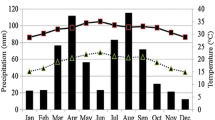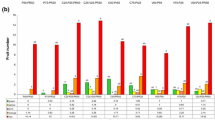Abstract
The study aims to evaluate the nutrient uptake and yield of tomato applied with vermicast using band and fertigation methods and enriched with vermi-foliar. A split-plot design was used with three replications. The main plot employed vermicast application (band and fertigation), and the subplots were enriched with variable amount of vermicast and vermi-foliar: vermicast (VC) alone, VC + vermi-tea, and VC + vermi-leachate. Result showed that the level of soil pH, organic matter, P2O5, and K2O was improved after two cropping periods. Both band and fertigation methods significantly increased (P = 0.001) the number of marketable fruits per plant and the fruit yield. Marketable yield was increased from 31.51 tons/ha in the vermicast alone to 36.51 tons/ha and NPK uptake of 5.15 g, 1.04 g, and 7.71 g, respectively, with the addition of vermi-tea. Tomato applied with vermicast using band method gave the highest yield of 35.60 tons/ha and nitrogen and phosphorus uptake of 4.41 g and 0.89 g. However, the nutrient uptake, as well as the number of marketable fruits per plant, was not influenced by band and fertigation methods and by the application of vermicast enriched with vermi-foliar, respectively.


Similar content being viewed by others
References
Alcantara CG (2015) Response of sweet corn (Zea mays var. rugosa) to drip fertigation in varying levels of nitrogen. 13:32–50
Alcantara CG, Gonzaga NR, Gonzaga AB, Pescadero IR, Quirino RA (2014) Promising tomato lines applied with vermicast in band and fertigation methods. ILS Res J 1:2014
Ali A, Zia MS, Hussain F, Salim M, Mahmood IA, Shahzad A (2005) Efficacy of different methods of potassium fertilizer application on paddy yield, K uptake and agronomic efficiency. 42:27–32
Arancon NQ (2006) Influences of vermicomposts on field strawberries: part 2. Effects on soil microbiological and chemical properties. 97:831–840. https://doi.org/10.1016/j.biortech.2005.04.016
Arthur GD (2012) Vermicompost leachate alleviates deficiency of phosphorus and potassium in tomato seedlings. HortScience 47:1304–1307
Azarmi R, Giglou MT, Didar R (2008) Influence of vermicompost on soil chemical and physical properties in tomato (Lycopersicum esculentum) field. Afr J Biotechnol 7:23977–22401
Bergougnoux V (2014) The history of tomato: from domestication to biopharming. Biotechnol Adv 32:170–189. https://doi.org/10.1016/j.biotechadv.2013.11.003
Chanda GK, Bhunia G, Chakraborty SK (2011) The effect of vermicompost and other fertilizers on cultivation of tomato plants. 3:42–45
Edwards CA, Arancon NQ, Greytak S, (2006) Effects of vermicompost teas on plant growth and disease 28–29
Ham GE, Nelson WW, Evans SD, Frazier RD (1973) Influence of fertilizer placement on yield response of soybeans. Agron J 65:81–84. https://doi.org/10.2134/agronj1973.00021962006500010025x
Havlin JL, Beaton JD, Tisdale JD, Nelson W (2005) Soil fertility and fertilizers: an introduction to nutrient management, 7th edition. Macmillan, New York
Lesaca RA (2013) There is gold in tomatoes. BAR Chron 14:5
Manyuchi MM, Mudamburi T (2013) Impact of vermicompost on lettuce cultivated soil. Int J Invent Eng Sci 1:41–43
Mengel D (n.d.) Roots, growth and nutrient uptake 08
Mercado AR (2011) Integrated soil and crop nutrient management in vegetable crops in the Southern Philippines: farmers’ practices and researches in vermicomposting, 2011
Mercado, A., Jr, A. Tulin, C Dorahy 2010. Soil management and crop nutrition for tomato in acid soil of Claveria, Philippines 270–273
Nzanza B, Marais D, Claassens AS (2014) Yield and fruit quality of tomato as affected by rates and ratios of K and Ca in water culture system. J Dep Plant Prod Soil Sci:156–160
Romero ES (2014) Microbial fertilizers for increasing and sustaining rice production on organic area and area under conversion. 3:349–354
Saidia PS, Rweyemamu CL, Asch F, Semoka J, Kimaro A, Germer J, Graef F, Lagweni P, Kahimba F, Chilagane EA (2018) Effects of nitrogen and phosphorus micro-doses on maize growth and yield in a sub-humid tropical climate. Ann Biol Res 9:20–35
Sárdi K (2011) Nutrient management. Pak J Agric Sci
Sinha RK, Agarwal S, Chauhan K, Valani D (2010) The wonders of earthworms and its vermicompost in farm production: Charles Darwin’s friends of farmers’, with potential to replace destructive chemical fertilizers from agriculture. Agric Sci 1:76–94. https://doi.org/10.4236/as.2010.12011
Taiz L, Zeiger E (2002) Mineral and nutrition, in: plant physiology. Sinauer Associates
Tsai WS, Shih SL, Venkatesan SG, Aquino MU, Green SK, Kenyon L, Jan F (2011) Distribution and genetic diversity of begomoviruses infecting tomato and pepper plants in the Philippines:275–287. https://doi.org/10.1111/j.1744-7348.2011.00462.x
Acknowledgment
The authors would like to acknowledge the Research, Development and Extension staff of the University of Science and Technology of Southern Philippines in Claveria, Philippines, for the support in the conduct of the study.
Author information
Authors and Affiliations
Corresponding author
Additional information
Publisher’s note
Springer Nature remains neutral with regard to jurisdictional claims in published maps and institutional affiliations.
Rights and permissions
About this article
Cite this article
Alcantara, C.G., Gonzaga, N.R. Nutrient uptake and yield of tomato (Solanum lycopersicum) in response to vermicast and vermi-foliar application. Org. Agr. 10, 301–307 (2020). https://doi.org/10.1007/s13165-019-00270-6
Received:
Accepted:
Published:
Issue Date:
DOI: https://doi.org/10.1007/s13165-019-00270-6




